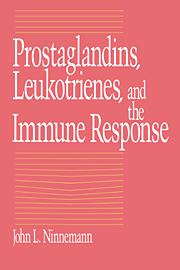Book contents
- Frontmatter
- Contents
- Foreword by James S. Goodwin
- Preface
- 1 A brief history and introduction
- 2 Prostaglandin/leukotriene structure and chemistry: a primer
- 3 Monocytes and macrophages
- 4 Lymphocyte response
- 5 Inflammation and the neutrophil
- 6 Malignancy and the arachidonic acid cascade
- 7 Tissue and organ transplantation
- 8 Rheumatoid arthritis and autoimmunity
- 9 Traumatic injury and surgery
- 10 Allergy
- Index
1 - A brief history and introduction
Published online by Cambridge University Press: 24 November 2009
- Frontmatter
- Contents
- Foreword by James S. Goodwin
- Preface
- 1 A brief history and introduction
- 2 Prostaglandin/leukotriene structure and chemistry: a primer
- 3 Monocytes and macrophages
- 4 Lymphocyte response
- 5 Inflammation and the neutrophil
- 6 Malignancy and the arachidonic acid cascade
- 7 Tissue and organ transplantation
- 8 Rheumatoid arthritis and autoimmunity
- 9 Traumatic injury and surgery
- 10 Allergy
- Index
Summary
The products of arachidonic acid metabolism, including the prostaglandins and the leukotrienes, are surprisingly versatile compounds, which participate in an extraordinary variety of normal physiological processes, such as maintaining blood pressure and body temperature, protecting organs from damage caused by disease, traumatic injury and stress, and regulating parturition. In addition, an imbalance in these same metabolites has been implicated in shock and a wide variety of disease states including arthritis, malignancy, and allergic disorders.
In spite of their great importance, most of the lay world and a large portion of the scientific and medical communities, were not introduced to the prostaglandins until the announcement of the Nobel Prize in Medicine for 1982. Swedish chemist Sune Bergström, his colleague Bengt Samuelsson, both of the Karolinska Institute, and British pharmacologist John Vane of Wellcome Research Laboratories received Nobel recognition for their part in determining the structure and the biological role of the prostaglandins. Bergström's pioneering contribution was the discovery that prostaglandins are synthesized in vivo from dietary polyunsaturated fatty acids. Along with von Euler, Bergstrom was able to purify and further characterize the prostaglandins, which had been discovered 20 years earlier. The metabolic fate and disposition of the prostaglandins in the body were determined mainly by Samuelsson and his group. Vane demonstrated the ability of antiinflammatory substances such as aspirin to inhibit prostaglandin synthesis. Bergström, Samuelsson, and Vane also participated in the elucidation of many of the fatty acid derivatives, and the recognition that they often work as antagonistic pairs.
- Type
- Chapter
- Information
- Publisher: Cambridge University PressPrint publication year: 1988

